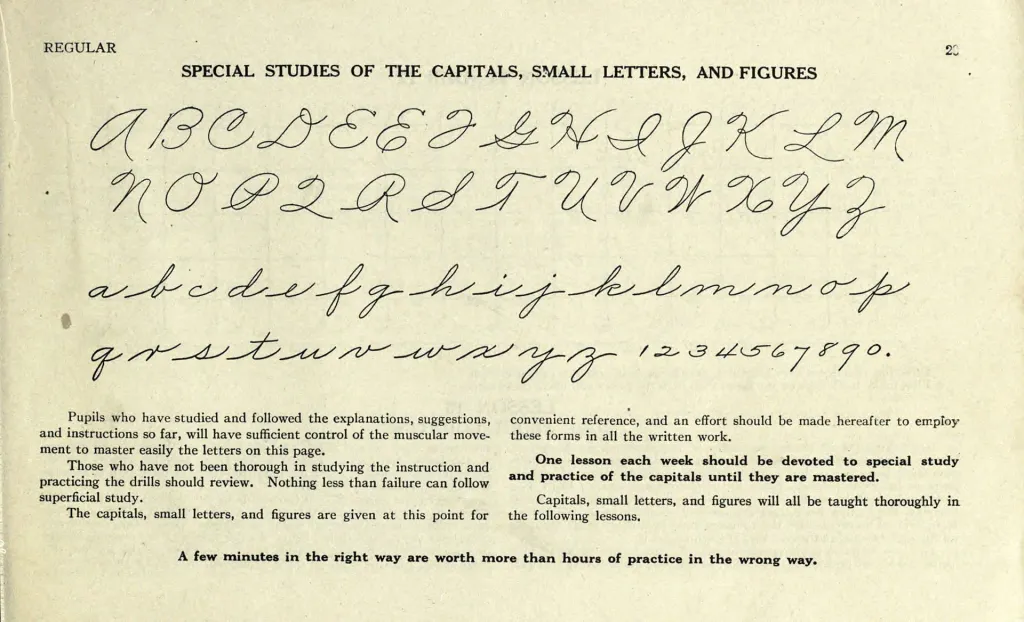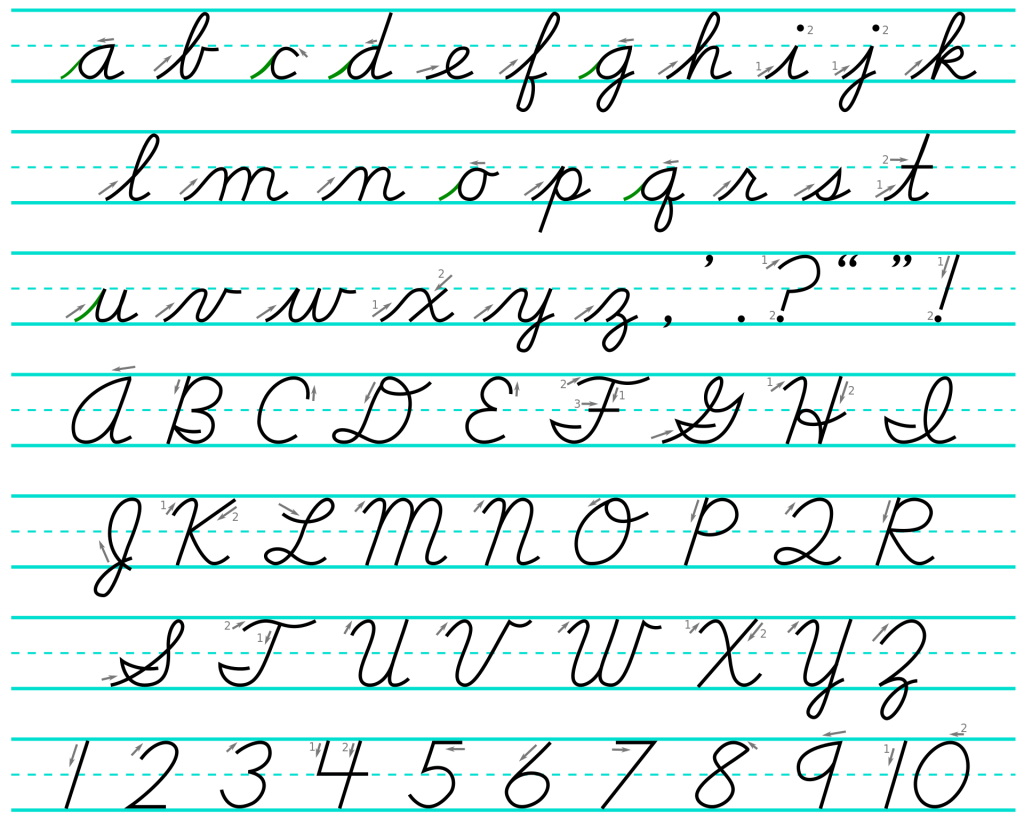by James Wallace Harris
I’ve been wanting to write by hand again, using cursive handwriting. For decades now, whenever I’ve had to write anything by hand, I printed it with block letters. It’s terribly slow. I keep trying to switch back to cursive so I can write faster and fluidly. However, the muscle memory of whatever cursive technique I was taught is faulty, causing frequent crashes in my penmanship. Such bumps in my inky road cause me to switch back to printing.
My friend Leigh Ann lent me The Art of Cursive Penmanship by Michael R. Sull after I mentioned to her that I wanted to learn handwriting again. Leigh Ann said most older people were taught the Palmer Method of penmanship, which was common in schools until the 1950s. In his book, Sull adapted a consensus of hand movements used in teaching the various forms of the Palmer Method and calls his version American Cursive. However, when he started using it, I realized I hadn’t learned to write certain letters that way, especially the upper-case F Q R and Z or the lower-case z. Here’s an example from Wikipedia.

I have a vague memory of learning cursive writing in school. I think it was in the third grade, which would have been the 1959-1960 school year for me. I completely have no memory of learning to write Qs and Zs this way. Now it’s possible that I’ve just forgotten. I’m forgetting words all the time nowadays, so why not forget some letters too?
According to Wikipedia, the Palmer Method might have been phased out by then and the new teaching method was called the Zaner-Bloser Method. It looks like this:

The differences are very slight. I think the big differences were in the teaching methods, especially how the hand and fingers were positioned and held. I believe each successive method aimed to make it easier for students to write by hand. It’s funny that most of us have forgotten this.
These are still the strange Qs and Zs. And I can’t make myself write zoo in cursive, either with a capital or lower case. It’s like my hand has no memory of writing Zs. Nor can I write anything with a capital Q. I do use that lower-case q.
Wikipedia says the Zaner-Bloser Method began to decline after the D’Nealian Method was introduced in 1978. It looks like this:

What’s weird is all the letters look about the same from method to method. It appears the physical method of writing them differs. I’ve also read that teaching penmanship varied depending on the teacher. I wonder if I had a weird teacher that didn’t like the Qs and Zs and created his/her own? (I went to three different third grade schools, in two states, and had a man, and two women teachers.)
What I’ve been learning this afternoon is my memory, especially my muscle memory, balks at writing some of these letters in the way they are being taught in their specific method. That suggests that the teacher taught me differently, or my teacher wasn’t paying close attention to me developing wayward habits. Do we all put our own spin on lettering? Is that why we have such a tough time reading each other’s cursive handwriting?
The reason I want to learn to write by hand again, using cursive, is because I want to write quickly and smoothly with a pen and have the results be easily readable. I’m not going for beautiful handwriting. I just want to develop a comfortable way to write with pen and paper. I keep reading that using pen and paper is better for my mind and memory than using a computer. I don’t know if that’s true or not, but I will assume it is until proven false.
I also have back trouble if I sit at the computer for too long, so I’m hoping to learn to write with pen and notebook while in my La-Z-Boy.
What I’ve decided to do is practice handwriting by studying these techniques in a general sense to see if I can figure out the smoothest way to cursively move from one letter to another. I want my writing to flow so I don’t have to think about it. If I could handwrite without letters crashing together, I think I would be satisfied.
I doubt I need to study a whole book, but I do need to do a lot of practice until I can figure out how my pen should move from one letter to the next depending on all the combinations. Michael R. Sull has people copy poems and other kinds of writing, and I think that’s a promising idea.
I do find it fascinating I was taught something around 1959/1960 that became muscle memory, and it should be a clue to which writing method I was taught.
JWH

Howdy! My name is Rick, and I think I’ve only been subscribing for a month or so. I’m just a year ahead of you, so your writings have almost been too relatable, but I consider that a good thing. I’ve been a sci-fi buff ever since i can remember, so I’ll be comparing notes with you on that, and also the TV shows that I grew up with. But for now, we must talk about cursive. I bounced back between Catholic and public schools when I was in elementary. None of the samples you showed seemed to match, but you are right about the different “methods” very similar. I have a theory of cursive I’ll share with you later, but I’d like to tell you what evolved with me, and why I think it works better than. cursive. Lacking a name until just now, let’s call it modified block drafting I took drafting in high school, and the first thing we practiced was block lettering standard for blueprints cira mid 1960’s. Block drafting is very slow because it is all caps. I can’t remember if we did the big-caps, little caps thing, but here’s what evolved for me. I reverted to the “pre-cursive” training and began printing again with occasionally linking some letters, but not all of them. There is probably no way I could beat a “cursive champ” for speed, but I seemed to get by with it, and I still do most of my composing by hand. Tonight is the first time I’ve keyboarded for a very long time. I’ll scare up some samples and run them through my scanner for you. I usually can fill ten or so double-spaced pages before my hands start feeling it, and then a short break, and then I can crank out a few more. The short part of my theory is that too much energy is used to keep cursive legible. Lifting the pen or pencil in theory slows one down, but I always felt that I could be speedier and more legible with my personally modified style. I honestly cannot remember if I started this in high school or in early college. If I find some samples when I’m sifting through my piles, I’ll let you know. (I’m remembering some science project notes that I may have kept bridging Jr Hi and High School.) I’ll attach the scans to your TV post when I respond to that. Take care. Rick
>
For decades I’ve been printing when I write with a pen, and I’ve gotten rather good at it. But I keep thinking it would feel more natural in terms of flow, to write cursive. I’m picking it up a little bit, and I think it will eventually work out that way. I think I’m going to end up with part printing and part cursive. For words that begin with a capital letter, I’ll print it, and then finish in cursive. I’ll see what you do when you post the samples.
Thanks for writing. I like hearing from other folks around my age to see how they are doing in retirement. What’s weird was back in the 1960s I seldom met people who read science fiction, but now in my old age, I hear from a lot of people who did.
The Capitals in these methods seems almost the same as lower case. I think I must reverse back to Printing for those. I tend to mix Cursive and Printing when I write.
Ugh those Qs! As a child I thought how silly they were, looking so much like the number 2. Now I’m wondering who ever thought that was a good idea. I remember I loved writing Zs though.
By the time I was in my teens (mid 60s) I was using a mix of cursive/printing which I still use now. I checked my own handwriting just now, by looking at a lengthy list I recently wrote and I’m surprised to see that my mix has evolved so that there are more joined letters than not. I’m sure that allows me to write more smoothly and legibly than if I used either cursive or block, especially when dashing off a quick note.
My speed is considerably helped by the abbreviations I use regularly. Here’s a few from that list I mentioned: req, rec’d, pu, reorg’d, canc’d, pd, ck/cking, w/o & w (I use both), chgd, sched’d, est, appt, bc, coz. I’m sure you already use a similar batch of abbrev’s.
I hope your endeavor works out and that you enjoy exercising your muscle memory.
I’ve never gotten into abbreviations. However, as I practice my cursive, I’ve discovered it feels more comfortable and practical to make some capital letters by printing, and then go into cursive. I’ve always thought of cursive as each word being one winding stroke of the pen, but for some letters, especially capitals, I can’t find a way to get from one letter to the next.
I taught elementary school for so long and the last 10 or so years have seen cursive writing fall by the wayside. It’s not taught in school anymore. The reason is that it’s not tested so it’s basically a waste of time for schools who depend on tests scores for funding. There aer teachers who say that teaching handwriting is basically teaching art and in Kindergarten a lot of work used to be put into developing those fine-motor skills.It seemed like little boys had an especially terrible time for some reason.
The D’Nealian looks most like the D’Nealian printing -and the method actually goes from printing to cursive to keep it as much the same as possible; same strokes and the same general look to it.
I had horrible handwriting until I was in about the 8th grade and developed a few of my own more stylized tricks. Still not good. Then working at the welfare department in the 1970s I got good because I had to write pages and pages of legible interview notes every day. My daughter had me write teh placards for her wedding. LOL!
I removed all the extra flourishes. I guess I minimal-ized it. The lower case G looks like an 8 but in the context of a word that was okay. I skipped some lines as being extraneous. Lately I’ve gone smaller and more round, but keeping the minimalist style.
However – if I’m not in the right mood my handwriting can be lousy again – handwriting experts and analysts would have a field day. LOL!
I’m doing something like what you did, adapting printing and cursive. I wish I had some examples of my handwriting from my school days. It would be interesting to see how it evolved or de-evolved.